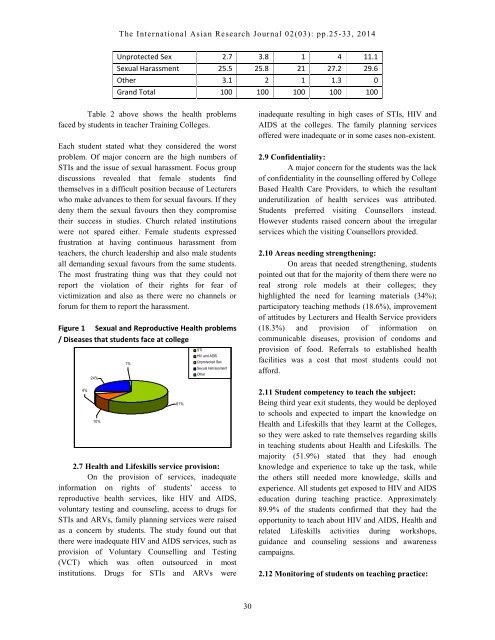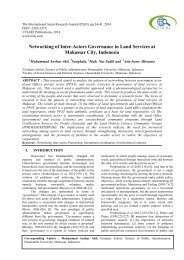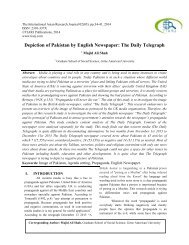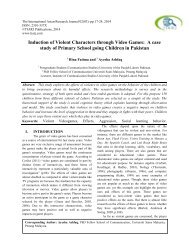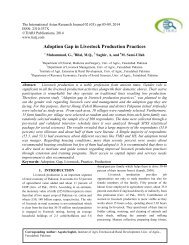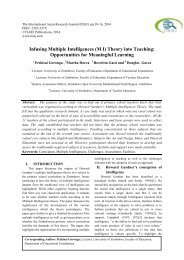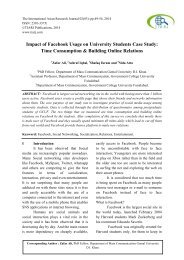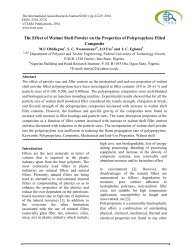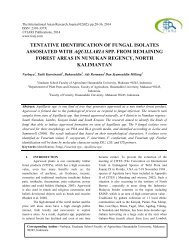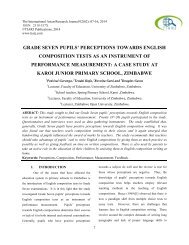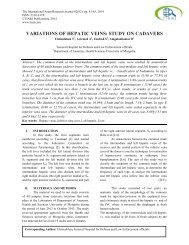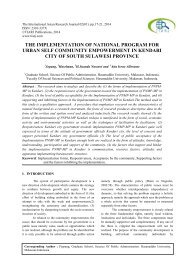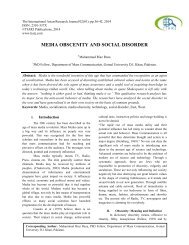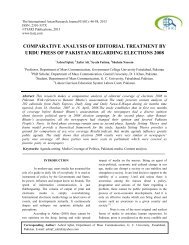Student Voices in the Implementation of Health and Lifeskills Policy in Zimbabwe Teacher Training Colleges. By: Priscilla Mujuru
Create successful ePaper yourself
Turn your PDF publications into a flip-book with our unique Google optimized e-Paper software.
The International Asian Research Journal 02(03): pp.25-33, 2014<br />
Unprotected Sex 2.7 3.8 1 4 11.1<br />
Sexual Harassment 25.5 25.8 21 27.2 29.6<br />
O<strong>the</strong>r 3.1 2 1 1.3 0<br />
Gr<strong>and</strong> Total 100 100 100 100 100<br />
Table 2 above shows <strong>the</strong> health problems<br />
faced by students <strong>in</strong> teacher Tra<strong>in</strong><strong>in</strong>g <strong>Colleges</strong>.<br />
Each student stated what <strong>the</strong>y considered <strong>the</strong> worst<br />
problem. Of major concern are <strong>the</strong> high numbers <strong>of</strong><br />
STIs <strong>and</strong> <strong>the</strong> issue <strong>of</strong> sexual harassment. Focus group<br />
discussions revealed that female students f<strong>in</strong>d<br />
<strong>the</strong>mselves <strong>in</strong> a difficult position because <strong>of</strong> Lecturers<br />
who make advances to <strong>the</strong>m for sexual favours. If <strong>the</strong>y<br />
deny <strong>the</strong>m <strong>the</strong> sexual favours <strong>the</strong>n <strong>the</strong>y compromise<br />
<strong>the</strong>ir success <strong>in</strong> studies. Church related <strong>in</strong>stitutions<br />
were not spared ei<strong>the</strong>r. Female students expressed<br />
frustration at hav<strong>in</strong>g cont<strong>in</strong>uous harassment from<br />
teachers, <strong>the</strong> church leadership <strong>and</strong> also male students<br />
all dem<strong>and</strong><strong>in</strong>g sexual favours from <strong>the</strong> same students.<br />
The most frustrat<strong>in</strong>g th<strong>in</strong>g was that <strong>the</strong>y could not<br />
report <strong>the</strong> violation <strong>of</strong> <strong>the</strong>ir rights for fear <strong>of</strong><br />
victimization <strong>and</strong> also as <strong>the</strong>re were no channels or<br />
forum for <strong>the</strong>m to report <strong>the</strong> harassment.<br />
Figure 1 Sexual <strong>and</strong> Reproductive <strong>Health</strong> problems<br />
/ Diseases that students face at college<br />
4%<br />
24%<br />
10%<br />
1%<br />
2.7 <strong>Health</strong> <strong>and</strong> <strong>Lifeskills</strong> service provision:<br />
On <strong>the</strong> provision <strong>of</strong> services, <strong>in</strong>adequate<br />
<strong>in</strong>formation on rights <strong>of</strong> students’ access to<br />
reproductive health services, like HIV <strong>and</strong> AIDS,<br />
voluntary test<strong>in</strong>g <strong>and</strong> counsel<strong>in</strong>g, access to drugs for<br />
STIs <strong>and</strong> ARVs, family plann<strong>in</strong>g services were raised<br />
as a concern by students. The study found out that<br />
<strong>the</strong>re were <strong>in</strong>adequate HIV <strong>and</strong> AIDS services, such as<br />
provision <strong>of</strong> Voluntary Counsell<strong>in</strong>g <strong>and</strong> Test<strong>in</strong>g<br />
(VCT) which was <strong>of</strong>ten outsourced <strong>in</strong> most<br />
<strong>in</strong>stitutions. Drugs for STIs <strong>and</strong> ARVs were<br />
61%<br />
STI<br />
HIV <strong>and</strong> AIDS<br />
Unprotected Sex<br />
Sexual Harrassment<br />
O<strong>the</strong>r<br />
<strong>in</strong>adequate result<strong>in</strong>g <strong>in</strong> high cases <strong>of</strong> STIs, HIV <strong>and</strong><br />
AIDS at <strong>the</strong> colleges. The family plann<strong>in</strong>g services<br />
<strong>of</strong>fered were <strong>in</strong>adequate or <strong>in</strong> some cases non-existent.<br />
2.9 Confidentiality:<br />
A major concern for <strong>the</strong> students was <strong>the</strong> lack<br />
<strong>of</strong> confidentiality <strong>in</strong> <strong>the</strong> counsell<strong>in</strong>g <strong>of</strong>fered by College<br />
Based <strong>Health</strong> Care Providers, to which <strong>the</strong> resultant<br />
underutilization <strong>of</strong> health services was attributed.<br />
<strong>Student</strong>s preferred visit<strong>in</strong>g Counsellors <strong>in</strong>stead.<br />
However students raised concern about <strong>the</strong> irregular<br />
services which <strong>the</strong> visit<strong>in</strong>g Counsellors provided.<br />
2.10 Areas need<strong>in</strong>g streng<strong>the</strong>n<strong>in</strong>g:<br />
On areas that needed streng<strong>the</strong>n<strong>in</strong>g, students<br />
po<strong>in</strong>ted out that for <strong>the</strong> majority <strong>of</strong> <strong>the</strong>m <strong>the</strong>re were no<br />
real strong role models at <strong>the</strong>ir colleges; <strong>the</strong>y<br />
highlighted <strong>the</strong> need for learn<strong>in</strong>g materials (34%);<br />
participatory teach<strong>in</strong>g methods (18.6%), improvement<br />
<strong>of</strong> attitudes by Lecturers <strong>and</strong> <strong>Health</strong> Service providers<br />
(18.3%) <strong>and</strong> provision <strong>of</strong> <strong>in</strong>formation on<br />
communicable diseases, provision <strong>of</strong> condoms <strong>and</strong><br />
provision <strong>of</strong> food. Referrals to established health<br />
facilities was a cost that most students could not<br />
afford.<br />
2.11 <strong>Student</strong> competency to teach <strong>the</strong> subject:<br />
Be<strong>in</strong>g third year exit students, <strong>the</strong>y would be deployed<br />
to schools <strong>and</strong> expected to impart <strong>the</strong> knowledge on<br />
<strong>Health</strong> <strong>and</strong> <strong>Lifeskills</strong> that <strong>the</strong>y learnt at <strong>the</strong> <strong>Colleges</strong>,<br />
so <strong>the</strong>y were asked to rate <strong>the</strong>mselves regard<strong>in</strong>g skills<br />
<strong>in</strong> teach<strong>in</strong>g students about <strong>Health</strong> <strong>and</strong> <strong>Lifeskills</strong>. The<br />
majority (51.9%) stated that <strong>the</strong>y had enough<br />
knowledge <strong>and</strong> experience to take up <strong>the</strong> task, while<br />
<strong>the</strong> o<strong>the</strong>rs still needed more knowledge, skills <strong>and</strong><br />
experience. All students get exposed to HIV <strong>and</strong> AIDS<br />
education dur<strong>in</strong>g teach<strong>in</strong>g practice. Approximately<br />
89.9% <strong>of</strong> <strong>the</strong> students confirmed that <strong>the</strong>y had <strong>the</strong><br />
opportunity to teach about HIV <strong>and</strong> AIDS, <strong>Health</strong> <strong>and</strong><br />
related <strong>Lifeskills</strong> activities dur<strong>in</strong>g workshops,<br />
guidance <strong>and</strong> counsel<strong>in</strong>g sessions <strong>and</strong> awareness<br />
campaigns.<br />
2.12 Monitor<strong>in</strong>g <strong>of</strong> students on teach<strong>in</strong>g practice:<br />
30


